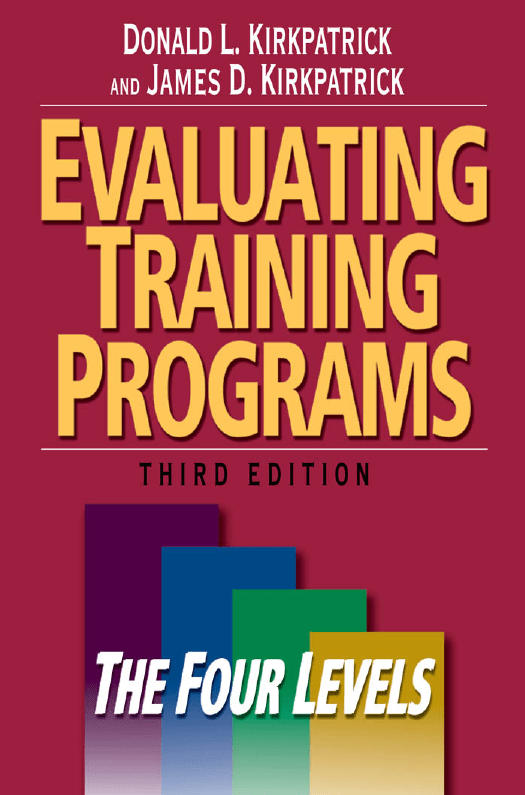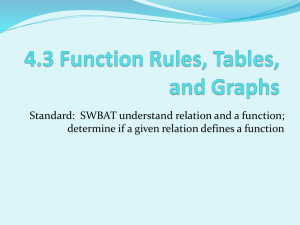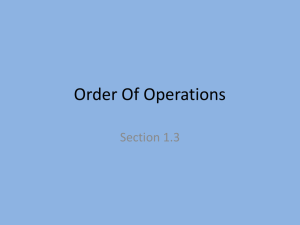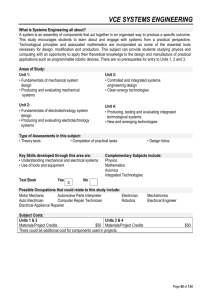
An Excerpt From
Evaluating Training Programs
by Donald L. Kirkpatrick and James D. Kirkpatrick
Published by Berrett-Koehler Publishers
Contents
Foreword
ix
Foreword to the Third Edition
xi
Preface
xv
Part One: Concepts, Principles, Guidelines,
and Techniques
1. Evaluating: Part of a Ten-Step Process
1
3
2. Reasons for Evaluating
16
3. The Four Levels:An Overview
21
4. Evaluating Reaction
27
5. Evaluating Learning
42
6. Evaluating Behavior
52
7. Evaluating Results
63
8. Implementing the Four Levels
71
9. Managing Change
75
10. Using Balanced Scorecards to Transfer Learning
to Behavior
82
11. So How Is E-Learning Different?
95
v
vi
Contents
Part Two: Case Studies of Implementation
115
12. Developing an Effective Level 1 Reaction Form:
Duke Energy Corporation
117
13. Evaluating a Training Program for Nonexempt
Employees: First Union National Bank
124
14. Evaluating a Training Program on Developing
Supervisory Skills: Management Institute,
University of Wisconsin
131
15. Evaluating a Leadership Training Program:
Gap Inc.
144
16. Evaluating a Leadership Development Program:
U.S. Geological Survey
168
17. Evaluating a Leadership Development Program:
Caterpillar, Inc.
186
18. Evaluating Desktop Application Courses:
Pollak Learning Alliance (Australia)
200
19. Evaluating an Orientation Program for New
Managers: Canada Revenue Agency, Pacific
Region
206
20. Evaluating Training for an Outage Management
System: PacifiCorp
221
21. Evaluating a Coaching and Counseling Course:
Grupo Iberdrola (Spain)
239
22. Evaluating a Performance Learning Model:
Defense Acquisition University
262
23. Evaluating an Information Technology Skills
Training Program:The Regence Group
276
24. Evaluating a Performance Improvement Program:
Toyota Motor Sales, U.S.A., Inc.
287
25. Evaluating a Career Development Initiative:
Innovative Computer, Inc.
321
Contents
vii
26. Evaluating the Four Levels by Using a New
Assessment Process:Army and Air Force
Exchange Service (AAFES)
343
27. Evaluating a Training Program at All Four Levels:
Cisco Systems, Inc.
351
Index
361
The Authors
373
Chapter 1
Evaluating: Part of a
Ten-Step Process
he reason for evaluating is to determine the effectiveness of a
training program.When the evaluation is done, we can hope that
the results are positive and gratifying, both for those responsible for
the program and for upper-level managers who will make decisions
based on their evaluation of the program. Therefore, much thought
and planning need to be given to the program itself to make sure that
it is effective. Later chapters discuss the reasons for evaluating and supply descriptions, guidelines, and techniques for evaluating at the four
levels.This chapter is devoted to suggestions for planning and implementing the program to ensure its effectiveness. More details can be
found in my book Developing Managers and Team Leaders (Woburn,
MA: Butterworth Heinemann, 2001).
Each of the following factors should be carefully considered when
planning and implementing an effective training program:
T
1.
2.
3.
4.
5.
6.
7.
8.
9.
10.
Determining needs
Setting objectives
Determining subject content
Selecting participants
Determining the best schedule
Selecting appropriate facilities
Selecting appropriate instructors
Selecting and preparing audiovisual aids
Coordinating the program
Evaluating the program
3
4
Concepts, Principles, Guidelines, and Techniques
Suggestions for implementing each of these factors follow.
Determining Needs
If programs are going to be effective, they must meet the needs of participants. There are many ways to determine these needs. Here are
some of the more common:
1. Ask the participants.
2. Ask the bosses of the participants.
3. Ask others who are familiar with the job and how it is being
performed, including subordinates, peers, and customers.
4. Test the participants.
5. Analyze performance appraisal forms.
Participants, bosses, and others can be asked in interviews or by
means of a survey. Interviews provide more detailed information, but
they require much more time. A simple survey form can provide
almost as much information and do it in a much more efficient
manner.
A survey form, such as the one shown in Exhibit 1.1, can be readily developed to determine the needs seen both by participants and by
their bosses.The topics to be considered can be determined by interviews or simply by answering the question, What are all the possible
subjects that will help our people to do their best? The resulting list
becomes the survey form.
As Exhibit 1.1 indicates, participants are asked to complete the survey by putting a check in one of three columns for each item.This is
a much better process than having them list their needs in order of
importance or simply writing down the topics that they feel will help
them to do their job better. It is important to have them evaluate each
topic so that the responses can be quantified.
After you tabulate their responses, the next step is to weight these
sums to get a weighted score for each topic.The first column, Of great
need, should be given a weight of 2; the second column, Of some need,
should be given a weight of 1; and the last column, a weight of 0.The
weighted score can then be used to arrive at a rank order for individual needs. If two topics are tied for third, the next rank is fifth, not
Evaluating
5
Exhibit 1.1. Survey of Training Needs
In order to determine which subjects will be of the greatest help to you in improving
your job performance, we need your input. Please indicate your need for each subject by placing an X in the appropriate column.
Subject
1 . Diversity in the workforce —understanding employees
2. How to motivate employees
3. Interpersonal communications
4. Written communication
5. Oral communication
6. How to manage time
7. How to delegate effectively
8. Planning and organizing
9. Handling complaints and grievances
10. How to manage change
11. Decision making and empowerment
12. Leadership styles— application
13. Performance appraisal
14. Coaching and counseling
15. How to conduct productive meetings
16. Building teamwork
17. How to discipline
18. Total quality improvement
19. Safety
20. Housekeeping
21. How to build morale— quality of work
life (QWL)
22. How to reward performance
23. How to train employees
24. How to reduce absenteeism and tardiness
25. Other topics of great need
1.
2.
Of great
need
Of some
need
Of no
need
6
Concepts, Principles, Guidelines, and Techniques
fourth, and if three needs have tied for seventh, the next rank is tenth.
This rank order provides training professionals with data on which to
determine priorities. Exhibit 1.2 illustrates the tabulations and the
rank order.
The same form can be used to determine the needs seen by the
bosses of the supervisors.The only change is in the instructions on the
form, which should read: “In order to determine which subjects
would be of greatest benefit to supervisors to help improve their performance, we need your input. Please put an X in one of the three
columns after each subject to indicate the needs of your subordinates
as you see them.Tabulations of this survey will be compared with the
needs that they see to decide the priority of the subjects to be
offered.”
There will be a difference of opinion on some subjects. For
example, in a manufacturing organization, the subject of housekeeping might be rated low by supervisors and high by their bosses. Other
topics, such as motivation, will probably be given a high rating by
both groups. In order to make the final decision on the priority of the
subjects to be offered, it is wise to use an advisory committee of managers representing different departments and levels within the organization.The training professional can show the committee members
the results of the survey and ask for their input.Their comments and
suggestions should be considered to be advisory, and the training professional should make the final decision.
Participation by an advisory committee accomplishes four purposes:
1. Helps to determine subject content for training programs.
2. Informs committee members of the efforts of the training
department to provide practical help.
3. Provides empathy regarding the needs seen by their subordinates.
4. Stimulates support of the programs by involving them in the
planning.
The use of tests and inventories is another approach for determining needs. There are two practical ways of doing this. One way is to
determine the knowledge, skills, and attitudes that a supervisor should
have and develop the subject content accordingly.Then develop a test
Evaluating
7
Exhibit 1.2.Tabulating Responses to Survey of Training Needs
In order to determine which subjects will be of the greatest help to you in improving
your job performance, we need your input. Please indicate your need for each subject by placing an X in the appropriate column.
Rank
order
Subject
Weighted
score
Of great Of some Of no
need
need
need
13
1 . Diversity in the workforce—
understanding employees
40
15
10
4
2. How to motivate employees
51
22
7
1
6
3. Interpersonal communications
48
20
8
2
5
18
4. Written communication
33
11
11
8
23
5. Oral communication
19
6
7
17
10
6. How to manage time
44
17
10
3
20
7. How to delegate effectively
29
9
11
10
20
8. Planning and organizing
29
6
17
7
14
9. Handling complaints and grievances
39
13
13
4
1
10. How to manage change
56
26
4
0
3
1 1 . Decision making and empowerment
53
24
5
1
6
12. Leadership styles— application
48
19
10
1
16
13. Performance appraisal
36
12
12
6
16
14. Coaching and counseling
36
8
20
2
20
15. How to conduct productive meetings
29
8
13
9
2
16. Building teamwork
55
25
5
0
9
17. How to discipline
47
18
11
1
14
18. Total quality improvement
39
13
13
4
11
19. Safety
43
15
13
2
23
20. Housekeeping
19
6
7
17
21. How to build morale—quality
of work life (QWL)
50
22
6
2
22. How to reward performance
41
17
7
6
23. How to train employees
48
19
10
1
24. How to reduce absenteeism
and tardiness
31
11
9
10
5
12
6
19
25. Other topics of great need
1.
2.
Note: Tabulated responses from thirty first-level supervisors.
8
Concepts, Principles, Guidelines, and Techniques
that measures the knowledge, skills, and attitudes, and give it to participants as a pretest. An analysis of the results will provide information
regarding subject content.
The other approach is to purchase a standardized instrument that
relates closely to the subject matter being taught.The sixty-five-item
Management Inventory on Managing Change (available from Donald
L. Kirkpatrick, 842 Kirkland Ct., Pewaukee, WI 53072) is such an
instrument. Here are some of the items in it:
1. If subordinates participate in the decision to make a change,
they are usually more enthusiastic in carrying it out.
2. Some people are not anxious to be promoted to a job that
has more responsibility.
3. Decisions to change should be based on opinions as well as
on facts.
4. If a change is going to be unpopular with your subordinates,
you should proceed slowly in order to obtain acceptance.
5. It is usually better to communicate with a group concerning a change than to talk to its members individually.
6. Empathy is one of the most important concepts in managing change.
7. It’s a good idea to sell a change to the natural leader before
trying to sell it to the others.
8. If you are promoted to a management job, you should make
the job different from what it was under your predecessor.
9. Bosses and subordinates should have an understanding
regarding the kinds of changes that the subordinate can
implement without getting prior approval from the boss.
10. You should encourage your subordinates to try out any
changes that they feel should be made.
Respondents are asked to agree or disagree with each statement.
The “correct” answers were determined by the author to cover concepts, principles, and techniques for managing change. It is important
to note that the possible answers are “agree” or “disagree” and not
“true” or “false.”
Five other standardized inventories are available from the source
just named: Supervisory Inventory on Communication, Supervisory
Inventory on Human Relations, Management Inventory on Time
Evaluating
9
Management, Management Inventory on Performance Appraisal and
Coaching, and Management Inventory on Leadership, Motivation,
and Decision Making.
Many other approaches are available for determining needs.Two of
the most practical—surveying participants and their bosses and giving
a pretest to participants before the program is run—have just been
described.
Setting Objectives
Once the needs have been determined, it is necessary to set objectives. Objectives should be set for three different aspects of the program and in the following order:
1. What results are we trying to accomplish? These results can
be stated in such terms as production, quality, turnover,
absenteeism, morale, sales, profits, and return on investment
(ROI).
2. What behaviors are needed to accomplish these desired
results?
3. What knowledge, skills, and attitudes are necessary to achieve
the desired behaviors?
The training program curriculum is then based on accomplishing no.
3. In some programs, only increased knowledge is needed. In others,
new or improved skills are necessary.And in some, change in attitudes
is what is needed. Diversity training is an example of a program
whose objective it is to change attitudes.
Determining Subject Content
Needs and objectives are prime factors when determining subject
content. Trainers should ask themselves the question, What topics
should be presented to meet the needs and accomplish the objectives?
The answers to this question establish the topics to be covered. Some
modifications may be necessary depending on the qualifications of
the trainers who will present the program and on the training budget.
10
Concepts, Principles, Guidelines, and Techniques
For example, the subject of managing stress may be important, but the
instructors available are not qualified, and there is no money to hire a
qualified leader or buy videotapes and/or packaged programs on the
subject. Other pertinent topics then become higher priorities.
Selecting Participants
When selecting participants for a program, four decisions need to
be made:
1.
2.
3.
4.
Who can benefit from the training?
What programs are required by law or by government edict?
Should the training be voluntary or compulsory?
Should the participants be segregated by level in the organization, or should two or more levels be included in the
same class?
In answer to the first question, all levels of management can benefit from training programs. Obviously, some levels can benefit more
than others.The answer to the second question is obvious. Regarding
the third question, I recommend that at least some basic programs be
compulsory for first-level supervisors if not also for others. If a program is voluntary, many who need the training may not sign up, either
because they feel they don’t need it or because they don’t want to
admit that they need it.Those who are already good supervisors and
have little need for the program can still benefit from it, and they can
also help to train the others.This assumes, of course, that the program
includes participatory activities on the part of attendees. To supplement the compulsory programs, other courses can be offered on a
voluntary basis.
Some organizations have established a management institute that
offers all courses on a voluntary basis.Training professionals may feel
that this is the best approach. Or higher-level management may discourage compulsory programs. If possible, the needs of the supervisors, as determined by the procedures described in the preceding
section, should become basic courses that should be compulsory.
Others can be optional. The answer to the last question depends on
Evaluating
11
the climate and on the rapport that exists among different levels of
management within the organization. The basic question is whether
subordinates will speak freely in a training class if their bosses are present. If the answer is yes, then it is a good idea to have different levels
in the same program.They all get the same training at the same time.
But if the answer is no, then bosses should not be included in the program for supervisors. Perhaps you can give the same or a similar program to upper-level managers before offering it to the first-level
supervisors.
Determining the Best Schedule
The best schedule takes three things into consideration: the trainees,
their bosses, and the best conditions for learning. Many times, training
professionals consider only their own preferences and schedules. An
important scheduling decision is whether to offer the program on a
concentrated basis—for example, as a solid week of training—or to
spread it out over weeks or months. My own preference is to spread it
out as an ongoing program. One good schedule is to offer a threehour session once a month.Three hours leave you time for participation as well as for the use of videotapes and other aids.The schedule
should be set and communicated well in advance.The day of the program and the specific time should be established to meet the needs
and desires of both the trainees and their bosses. Line managers should
be consulted regarding the best time and schedule.
I recently conducted a week-long training program for all levels of
management at a company in Racine, Wisconsin. Two groups of
twenty each attended the program. The first session each day was
scheduled from 7:00 to 10:30 a.m. The repeat session for the other
group was scheduled from 3:00 to 6:30 p.m. Racine was too far away
to go home each day, and what do you do in Racine from 10:30 a.m.
to 3:00 p.m. each day for a week? This is the worst schedule I ever had,
but it was the best schedule for all three shifts of supervisors who
attended.The point is, the training schedule must meet the needs and
desires of the participants instead of the convenience of the
instructors.
12
Concepts, Principles, Guidelines, and Techniques
Selecting Appropriate Facilities
The selection of facilities is another important decision. Facilities
should be both comfortable and convenient. Negative factors to be
avoided include rooms that are too small, uncomfortable furniture,
noise or other distractions, inconvenience, long distances to the training room, and uncomfortable temperature, either too hot or too cold.
A related consideration has to do with refreshments and breaks. I conducted a training program on managing change for a large Minneapolis company. They provided participants with coffee and sweet
rolls in the morning, a nice lunch at noon, and a Coke and cookie
break in the afternoon. Participants came from all over the country,
including Seattle. In order to save money on transportation and hotel,
the company decided to take the program to Seattle, where it had a
large operation. In Seattle, no refreshments were offered, and participants were on their own for lunch. Unfortunately, some peers of the
participants had attended the same program in Minneapolis. These
factors caused negative attitudes on the part of those attending. And
these attitudes could have affected their motivation to learn as well as
their feeling toward the organization and the training department in
particular. Incidentally, more and more companies are offering fruit
instead of sweet rolls and cookies at breaks.
Selecting Appropriate Instructors
The selection of instructors is critical to the success of a program.
Their qualifications should include a knowledge of the subject being
taught, a desire to teach, the ability to communicate, and skill at getting people to participate. They should also be “learner oriented”—
have a strong desire to meet learner needs.
Budgets may limit the possibilities. For example, some organizations limit the selection to present employees, including the training
director, the Human Resources manager, and line and staff managers.
There is no money to hire outside leaders.Therefore, subject content
needs to be tailored to the available instructors, or else instructors
need to receive special training. If budgets allow, outside instructors
can be hired if internal expertise is not available.The selection of these
Evaluating
13
instructors also requires care. Many organizations feel that they have
been burned because they selected outside instructors who did a poor
job. In order to be sure that a potential instructor will be effective, the
best approach is to observe his or her performance in a similar situation. The next best approach is to rely on the recommendations of
other training professionals who have already used the individual. A
very unreliable method is to interview the person and make a decision based on your impressions.
I recently conducted a workshop for eighty supervisors and managers at St.Vincent Hospital in Indianapolis. I had been recommended
to Frank Magliery, vice president of Operations, by Dave Neil of ServiceMaster. Dave had been in several of my sessions. In order to be
sure that I was the right instructor, Frank attended another session
that I did for ServiceMaster. He was able therefore not only to judge
my effectiveness but also to offer suggestions about tailoring the training to his organization.
This is the kind of selection process that should be followed when
you hire an outside consultant. It not only illustrates a process for
selection but also emphasizes the importance of orienting an outside
leader to the needs and desires of the specific organization.
Selecting and Preparing Audiovisual Aids
An audiovisual aid has two purposes: to help the leader maintain
interest and to communicate. Some aids, hopefully only a few minutes
long, are designed to attract interest and entertain.This is fine providing they develop a positive climate for learning.When renting or purchasing videotapes and packaged programs, take care to preview them
first to be sure that the benefits for the program outweigh the cost.
The extent to which such aids should become the main feature of a
program depends on the instructor’s knowledge and skills in developing his or her own subject content. Some organizations rely entirely
on packaged programs because they have the budget but not the skills
needed to develop and teach programs of their own. Other training
professionals rely primarily on their own knowledge, skill, and materials, and rent or buy videos only as aids. Some organizations have a
department that can make effective aids and provide the necessary
14
Concepts, Principles, Guidelines, and Techniques
equipment. Other organizations have to rent or buy them. The
important principle is that aids can be an important part of an effective program. Each organization should carefully make or buy the aids
that will help it to maintain interest and communicate the message.
Coordinating the Program
Sometimes the instructor coordinates as well as teaches. In other situations a coordinator does not do the teaching. For those who coordinate and do not teach, there are two opposite approaches.
As an instructor, I have experienced two extremes in regard to
coordination. At an eastern university offering continuing education,
I had to introduce myself, find my way to the lunchroom at noon, tell
participants where to go for breaks, conclude the program, and even
ask participants to complete the reaction sheets. I couldn’t believe that
a university that prided itself on professional programming could do
such a miserable job of coordinating.
The other extreme occurred in a program that I conducted for
State Farm Insurance in Bloomington, Illinois. Steve Whittington and
his wife took my wife, Fern, and me out to dinner the evening before
the program. He picked me up at the hotel to take me to the training
room in plenty of time to set the room up for the meeting. He made
sure that I had everything I needed. He introduced me and stayed for
the entire program, helping with handouts. He handled the breaks.
He took me to lunch and, of course, paid for it. He concluded the
meeting by thanking me and asking participants to complete reaction
sheets. He took me back to the hotel and thanked me. In other
words, he served as an effective coordinator who helped to make the
meeting as effective as possible. Of course, the niceties that he
included are not necessary for effective coordination, but they do
illustrate that it is important to meet the needs of the instructor as
well as of the participants.
Evaluating the Program
Details on evaluation are provided in the rest of the book.
As stated at the beginning of this chapter, to ensure the effective-
Evaluating
15
ness of a training program, time and emphasis should be put on the
planning and implementation of the program.These are critical if we
are to be sure that, when the evaluation is done, the results are positive. Consideration of the concepts, principles, and techniques
described in this chapter can help to ensure an effective program.
Chapter 2
Reasons for Evaluating
t a national conference of the National Society for Sales Training
Executives (NSSTE), J. P. Huller of Hobart Corporation presented a paper on “evaluation.” In the introduction, he says,“All managers, not just those of us in training, are concerned with their own
and their department’s credibility. I want to be accepted by my company. I want to be trusted by my company. I want to be respected by
my company. I want my company and my fellow managers to say,‘We
need you.’”
“When you are accepted, trusted, respected, and needed, lots and
lots of wonderful things happen:
A
•
•
•
•
•
•
Your budget requests are granted.
You keep your job. (You might even be promoted.)
Your staff keep their jobs.
The quality of your work improves.
Senior management listens to your advice.
You’re given more control.
“You sleep better, worry less, enjoy life more. . . . In short, it makes
you happy.”
“Wonderful! But just how do we become accepted, trusted,
respected, and needed? We do so by proving that we deserve to be
accepted, trusted, respected, and needed. We do so by evaluating and
reporting upon the worth of our training.”
16
Reasons for Evaluating
17
This states in general terms why we need to evaluate training. Here
are three specific reasons:
1. To justify the existence and budget of the training department by showing how it contributes to the organization’s
objectives and goals
2. To decide whether to continue or discontinue training programs
3. To gain information on how to improve future training
programs
There is an old saying among training directors: When there are
cutbacks in an organization, training people are the first to go. Of
course, this isn’t always true. However, whenever downsizing occurs,
top management looks for people and departments that can be eliminated with the fewest negative results. Early in their decision, they
look at such “overhead” departments as Training, commonly called
Corporate University, and Human Resources, which typically
includes Employment, Salary Administration, Benefits, and Labor
Relations (if there is a union). In some organizations, top management
feels that all these functions except training are necessary. From this
perspective, training is optional, and its value to the organization
depends on top executives’ view of its effectiveness. Huller is right
when he states that training people must earn trust and respect if
training is to be an important function that an organization will want
to retain even in a downsizing situation. In other words, trainers must
justify their existence. If they don’t and downsizing occurs, they may
be terminated, and the training function will be relegated to the
Human Resources manager, who already has many other hats to wear.
The second reason for evaluating is to determine whether you
should continue to offer a program. The content of some programs
may become obsolete. For example, programs on Work Simplification, Transactional Analysis, and Management by Objectives were
“hot” topics in past years. Most organizations have decided to replace
these with programs on current hot topics such as Diversity, Empowerment, and Team Building. Also, some programs, such as computer
training, are constantly subject to change. Some programs are offered
on a pilot basis in hopes that they will bring about the results desired.
18
Concepts, Principles, Guidelines, and Techniques
These programs should be evaluated to determine whether they
should be continued. If the cost outweighs the benefits, the program
should be discontinued or modified.
The most common reason for evaluation is to determine the effectiveness of a program and ways in which it can be improved. Usually,
the decision to continue it has already been made.The question then
is, How can it be improved? In looking for the answer to this question, you should consider these eight factors:
1. To what extent does the subject content meet the needs of
those attending?
2. Is the leader the one best qualified to teach?
3. Does the leader use the most effective methods for maintaining interest and teaching the desired attitudes, knowledge,
and skills?
4. Are the facilities satisfactory?
5. Is the schedule appropriate for the participants?
6. Are the aids effective in improving communication and
maintaining interest?
7. Was the coordination of the program satisfactory?
8. What else can be done to improve the program?
A careful analysis of the answers to these questions can identify ways
and means of improving future offerings of the program.
When I talked to Matt, a training director of a large bank, and
asked him to write a case history on what his organization has done
to evaluate its programs, here is what he said:“We haven’t really done
anything except the ‘smile’ sheets.We have been thinking a lot about
it, and we are anxious to do something. I will be the first one to read
your book!”
This is the situation in many companies. They use reaction sheets
(or “smile” sheets, as Matt called them) of one kind or another. Most
are thinking about doing more.They haven’t gone any further for one
or more of the following reasons:
•
•
•
•
They don’t consider it important or urgent.
They don’t know what to do or how to do it.
There is no pressure from higher management to do more.
They feel secure in their job and see no need to do more.
Reasons for Evaluating
19
• They have too many other things that are more important or
that they prefer to do.
In most organizations, both large and small, there is little pressure
from top management to prove that the benefits of training outweigh
the cost. Many managers at high levels are too busy worrying about
profits, return on investment, stock prices, and other matters of concern to the board of directors, stockholders, and customers.They pay
little or no attention to training unless they hear bad things about it.
As long as trainees are happy and do not complain, trainers feel comfortable, relaxed, and secure.
However, if trainees react negatively to programs, trainers begin to
worry, because the word might get to higher-level managers that the
program is a waste of time or even worse. And higher-level managers
might make decisions based on this information.
In a few organizations, upper-level managers are putting pressure
on trainers to justify their existence by proving their worth. Some
have even demanded to see tangible results as measured by improvements in sales, productivity, quality, morale, turnover, safety records,
and profits. In these situations, training professionals need to have
guidelines for evaluating programs at all four levels. And they need to
use more than reaction sheets at the end of their programs.
What about trainers who do not feel pressure from above to justify
their existence? I suggest that they operate as if there were going to
be pressure and be ready for it. Even if the pressure for results never
comes, trainers will benefit by becoming accepted, respected, and
self-satisfied.
Summary
There are three reasons for evaluating training programs. The most
common reason is that evaluation can tell us how to improve future
programs. The second reason is to determine whether a program
should be continued or dropped. The third reason is to justify the
existence of the training department (Corporate University) and its
budget. By demonstrating to top management that training has tangible, positive results, trainers will find that their job is more secure, even
if and when downsizing occurs. If top-level managers need to cut
20
Concepts, Principles, Guidelines, and Techniques
back, their impression of the need for a training department will
determine whether they say, “That’s one department we need to
keep” or “That’s a department that we can eliminate or reduce without hurting us.”And their impression will be be greatly influenced by
trainers who evaluate at all levels and communicate the results
to them.
this material has been excerpted from
Evaluating Training Programs
by Donald L. Kirkpatrick and James D. Kirkpatrick
Published by Berrett-Koehler Publishers
Copyright © 2009, All Rights Reserved.
For more information, or to purchase the book,
please visit our website
www.bkconnection.com






